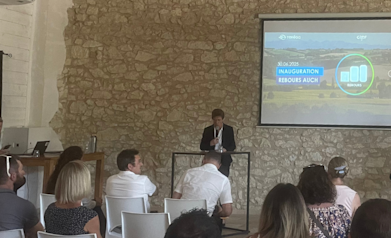Urgence gaz 0 800 028 800
How does a methanisation unit work?
The methanisation process, allowing biogas and biomethane to be produced from organic waste, takes place within a methanisation unit.
Methanisation is a natural process that works according to the anaerobic digestion principle: organic matter (methanisation inputs) is broken down by the action of bacteria in a low-oxygen environment, leading to the production of methane. To achieve this, a methanisation system is required. How does it work?
1- Organic waste (livestock effluents, agricultural waste etc.) is first stored in a storage building, where its quality is regularly checked.
2- Little by little, that material is introduced into the digester (or methaniser), a large tank in which it becomes part of the oxygen-free decomposition process. The waste is mixed, heated and deprived of oxygen to optimise the process of being broken down by micro-organisms. There are different plants for dry and wet methanisation, depending on the nature of the inputs.
3- This biological reaction enables biogas to be produced. At the end of the methanisation process, residual matter is left: digestate. This is stored in the post-digester and can then be used as natural fertiliser, as a substitute for chemical fertilisers.
4- The biogas produced can then be used for cogeneration of heat and electricity. The methanisation unit can also be connected to the natural gas grid. In this case, the biogas is purified to obtain biomethane which can be injected into the network. A network operator installs an injection unit which is used to odorise the biomethane and check its quality prior to injection.
Biomethane injection is encouraged by the public authorities because it helps increase the proportion of renewable energies in French consumption, while contributing to the circular economy in the regions. Teréga can support you in your methanisation project.
Votre avis nous intéresse !
Pour aller plus loin
Sur la même thématique
En savoir plus
![Inauguration rebours de Auch]()
TEREGA and GRDF inaugurate the first injection station in Occitanie
Biomethanisation at Auros : AgriEnergie site opening
![]()
Gas for Climate : New study on biomethane potentials in Europe


